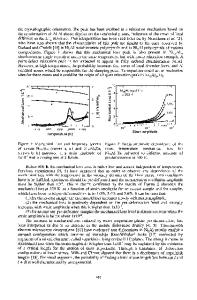The Critical Stress for Plastic Deformation in Ni 3 (Al,Hf) Single Crystals
- PDF / 363,450 Bytes
- 6 Pages / 420.48 x 639 pts Page_size
- 71 Downloads / 374 Views
THE CRITICAL STRESS FOR PLASTIC DEFORMATION IN Ni3(AI,Hf) SINGLE CRYSTALS. P. Spftig, J. Bonneville and J-L. Martin Ecole Polytechnique Fdddrale de Lausanne, Institut de Gdnie Atomique, Ddpartement de Physique, 1015 Lausanne (Switzerland). ABSTRACT A new method of relaxation series is proposed which allows for the measurement of the apparent activation volumes and of the hardening correction terms. This method is successfully applied to the measurement of the effective activation volumes along the stress strain curves. A transition stress between a microplastic and a macroplastic domain can be unambiguously defined on the plots of the effective volume as a function of strain. The corresponding transition stress measured at three temperatures in the range of the flow stress anomaly (293K, 423K, 573K), agrees reasonably well with the values of T0.2%. The latter stress was usually considered as the critical stress for plastic deformation, in former studies. 1. INTRODUCTION The flow strength anomaly of Ni3 A1 compounds has been studied extensively and a number of models have been proposed to explain this peculiar behaviour [1]. It has generally been accepted that : i) below the 2.10-3 yield stress (TO.2%, i.e. the stress necessary to give a plastic strainfy. of 2.10-3), deformation corresponds to the rapid motion of edge dislocations that lead to a normal temperature dependence while ii) above t0.2%, flow is associated with the more difficult propagation of screw dislocations that yields the anomalous temperature dependence [2]. The models attempt to describe the temperature, sense and orientation dependences of r0.2% • The validity of using the T0.2% stress as the critical stress for screw dislocation motion in Ni 3 Al compounds has been recently questioned [3, 4]. The main objections, that were addressed, are based on the following experimental observations : i) the 10-4 yield stress (i.e. to.01%) exhibits already a clear anomalous behaviour with temperature [5], ii) extensive octahedral glide occurs during primary creep at stresses below T0.2 %, iii) the stress-strain curves do not exhibit any distinct yield point. Previous studies on the strain rate sensitivity of stress [6, 7] have indicated that, at least during stress relaxation experiments performed along the stress strain curve of Ni3 (A1,Ta) single crystals, a normal thermal activation of dislocation motion takes place. In the framework of the thermal activation theory, this allows us to determine an activation volume that characterizes the strain rate sensitivity of the stress. It is expected that this parameter will undergo an abrupt change when there is a change in the microscopic mechanism that controls deformation. It has been shown, for instance, that the strain dependence of the activation volume clearly indicates the transition stress between the micro- and macro-plastic domains in various type of materials [8, 9, 10]. The present paper is devoted to the characterization of a critical stress between the microand macro- plastic domains. For this, activ
Data Loading...











